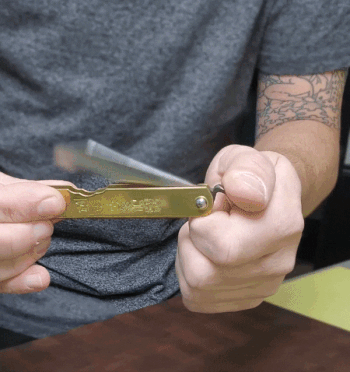FREE SHIPPING (Orders over $99 CAD)
FREE SHIPPING
(Orders over $99 CAD)

The rich history of Higonokami knives is a testament to the craftsmanship and innovation that has evolved over the years. These distinctive Japanese folding pocket knives have a story dating back to the late 19th century, steeped in tradition and ingenuity.
Befove we delve into the fascinating journey of Higonokami knives, let's get straight to the point with one of the most frequently asked question; What is written on a Higonokami?
Here it is defined, by section:
The top square (登録商標) : Registered Trademark
The 2 first Kanji (肥後) : Higo (is the province)
The 1 middle Kanji (守) : Kami (is a governor)
The 3 bottom Kanji (定ᄀ駒) : Sada Kanekoma (is the maker)

The name "Higonokami" carries historical significance, with the kanji used to spell it meaning the "Governor of Higo." This title referred to the most senior administrative position, or Kokushi, responsible for governing Higo, an old province on the island of Kyūshū, which is now part of Kumamoto Prefecture. The term "Kami" in Higonokami is represented by the kanji 守, signifying "protector."
Here is Higonokami's friction opening mechanism, in motion:

To view our Higonokami collection: Click here!
Origins in the 1880s
Higonokami knives owe their existence to the collaborative efforts of Mr. Komataro Nagao and Mr. Murakami, who embarked on a journey to produce knives in Hirata, Miki City in the 1880s. During those days, knives were meticulously handcrafted, with steel skillfully inserted into iron edges and meticulously forged. The sheaths were a work of art, crafted from brass and black-dyed iron plating, often adorned with intricate carvings depicting portraits, horses, flowers, birds, and landscapes. It was a labor-intensive process, as a single craftsman could only produce 5 to 8 sets of these exquisite knives in a day.

The Birth of the Higonokami Knife
In 1894, Mr. Tasaburo Shigematsu, a hardware wholesaler, introduced a revolutionary design. Inspired by a knife he brought back from Kagoshima, he innovatively added a small handle, known as "Chikiri," to the blade, allowing it to fold seamlessly into the sheath. This new creation was named the "Higonokami Knife," as many of his customers hailed from the Kumamoto area, formerly known as Higo country. This change proved to be a game-changer, leading to a significant increase in sales.
Evolving Shapes and Royal Recognition
The design of Higonokami blades gradually evolved. Unlike their single-edged predecessors, these knives featured double-edged blades with a V-shaped cross-section. Initially, the blades had a distinctive sharp tip resembling a bamboo leaf, but over time, they transitioned to a square shape. Sheaths followed a similar transformation, moving from a vertical folding style to a cross-folding style. Today, the vertical folding style is a custom-made option.
In 1911, at the First Kobe Export Articles Competitive Exhibition, Higonokami received a remarkable accolade when Crown Prince (later Emperor Taisho) admired and purchased one of these knives, further elevating their reputation.
The Higonokami Knife Union and Trademark Registration
In 1899, the "Higonokami Knife Union" was established, becoming a prominent force in the industry's golden age. At its peak, the union comprised 40 member companies with more than 200 workers. However, challenges arose as inferior imitations flooded the market, causing issues for the authentic Higonokami makers.
To protect their brand, the decision was made to obtain a trademark registration for Higonokami in 1910. Consequently, the use of the "Higonokami Brand" became restricted to the members of the Miki Knife Manufacturers Association. As time marched on, the industry faced new challenges. The introduction of utility knives and pencil sharpeners, coupled with a social campaign against knives in the 1950s, dealt a severe blow to the industry. Many manufacturers had to change their line of work or cease operations, leaving Nagao Kanakoma Knife as the sole manufacturer permitted to use the "Higonokami" trademark.

A Unique Craft: The Higonokami Knife
The Higonokami knife is a distinctive folding pocket knife with a rich heritage. It operates as a friction folder, relying on the friction of the swivel or the pressure of the user's thumb on its iconic lever or chikiri to prevent the knife from folding during use.
The handles are now made of various wood styles, but most popularly, a folded-over sheet of metal, bearing the maker's name and the steel used in the blade.
Notably, the blades feature a flat grind without a secondary bevel. With various combinations, the models are now limitless, from basic everyday utility blades, up to collector's pieces made by collaborations, like this Aranea:

A Legacy Preserved
Today, Higonokami knives are more than just tools; they represent a heritage of craftsmanship and innovation. The name "Higonokami" is trademarked by the Miki Custom Knife Guild, which decides which brands can bear this prestigious title.
Only one fifth-generation manufacturer, KaneKoma, is legally allowed to call its knives exclusively "Higonokami." Other knifemakers, whether they craft traditional or modernized versions of Higonokami, must refer to their products as "Higo" or "Higonokami-style."
In a world of ever-changing trends and technology, Higonokami knives stand as a symbol of tradition, quality, and resilience. Their enduring legacy continues to captivate knife enthusiasts and collectors worldwide, preserving the craftsmanship and artistry of a bygone era.
Leave a comment